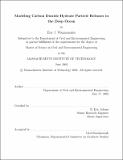Modeling carbon dioxide particle releases in the deep ocean
Author(s)
Wannamaker, Eric J. (Eric Joseph), 1975-
DownloadFull printable version (748.9Kb)
Alternative title
Modeling CO₂ particle releases in the deep ocean
Other Contributors
Massachusetts Institute of Technology. Dept. of Civil and Environmental Engineering.
Advisor
E. Eric Adams.
Terms of use
Metadata
Show full item recordAbstract
This work investigates the environmental impacts of releasing solid CO₂ hydrate particles into the deep ocean for the purpose of CO₂ sequestration. Release of CO₂ in this form may be desirable as hydrate particles are negatively buoyant in seawater, and dissolution of CO₂ enhances this negative buoyancy via the solute density effect. Hence, the total plume thickness of a negatively buoyant CO₂ hydrate plume may exceed that of positively buoyant CO₂ release. This is seen as a potential advantage both in terms of dilution and sequestration depth. A brief description of the two-phase integral plume model used for stagnant plume modeling is given as well as some background in multi-phase plume physics. Physical and chemical properties relevant to CO₂ hydrates and the ocean environment are discussed, as well as a description of the applicable carbonate chemistry. The integral model used for plume modeling is calibrated based on available data, as is the mass transfer model. The impact of mean particle size particle size distribution, and mass injection rate on relevant integrated parameters is explored via numerical modeling. A brief comparison of the plume group effect for positive and negative buoyancy is presented as well. Three different CO₂ release scenarios, including a hydrate particle plume, a towed pipe release, and a manifold based liquid CO₂ release are compared in terms of their pH impact to the water column.
Description
Thesis (S.M.)--Massachusetts Institute of Technology, Dept. of Civil and Environmental Engineering, 2002. Includes bibliographical references (p. 93-97). This electronic version was submitted by the student author. The certified thesis is available in the Institute Archives and Special Collections.
Date issued
2002Department
Massachusetts Institute of Technology. Department of Civil and Environmental EngineeringPublisher
Massachusetts Institute of Technology
Keywords
Civil and Environmental Engineering.